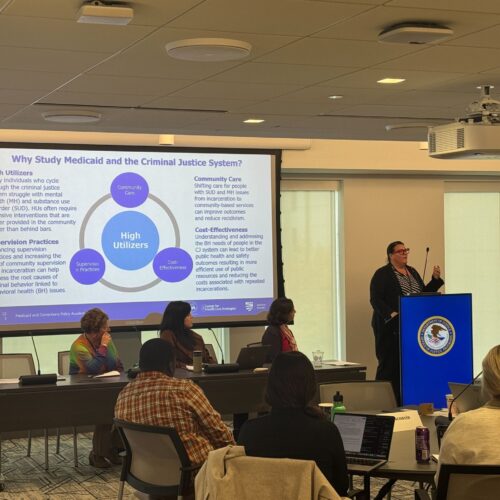Implementing Evidence-Based Strategies to Reduce Overdose Risk during Reentry
A Primer for Reentry Professionals
Too often, people reentering the community from incarceration experience fatal overdoses, with studies showing that they are at a highest risk of an overdose or even death during the first 48 hours after release. This is typically related to a decrease in tolerance while in prison or jail, so their body is more vulnerable to overdosing even when using at the same amount they did before they were incarcerated. This risk is highest among people using opioids. Fortunately, there are evidence-based practices that can be implemented to support safe and successful transitions. This guide outlines four best practices that reentry professionals can implement to reduce overdose risk during reentry.
Implementing Evidence-Based Strategies to Reduce Overdose Risk during Reentry
A Primer for Reentry Professionals

Too often, people reentering the community from incarceration experience fatal overdoses, with studies showing that they are at a highest risk of an overdose or even death during the first 48 hours, and that risk continues 2 weeks following release into the community.1
Often, this is related to a decrease in tolerance. While in prison or jail, people have limited or no access to substances, so their body is more vulnerable to overdosing even when using at the same amount they did before they were incarcerated.
In fact, one study found that the first two weeks after release from prison was 129 times riskier for people with substance use disorder (SUD) than that of any other state residents.2
 This risk is highest among people using opioids. With 19 percent of people incarcerated in prisons and jails in 2020 reporting regular use of opioids, it is increasingly important for reentry plans to include strategies to reduce overdose.3
This risk is highest among people using opioids. With 19 percent of people incarcerated in prisons and jails in 2020 reporting regular use of opioids, it is increasingly important for reentry plans to include strategies to reduce overdose.3
While addiction is a chronic disease, like diabetes or heart disease, people can and do achieve stable recovery. Indeed, according to a recent study, over 22 million Americans, equivalent to approximately 9 percent of the population, have “resolved” an alcohol or other SUD.4 This means behavioral health and criminal justice practitioners responsible for preparing people to be released or working with people who have been recently released from jail or prison should work together to support successful recovery. But those efforts must start with understanding the evidence-based practices and supports that increase the likelihood of safe and successful transitions. This pamphlet outlines five evidence-based best practices for reducing overdose risk during reentry.
Five Best Practices to Reduce the Chances of Overdose
1. Use Medications to Treat Opioid Use Disorders
According to the Center for Disease Control and Prevention (CDC), the provisional counts of overdose deaths in the United States surpassed 106,000 people in July 2023, which is an increase of over 2 percent from the previous year.5 Therefore, while there are many other substances people can be addicted to, such as alcohol, the risk of overdose death from opioids remains incredibly high. To help mitigate this concern, the U.S. Food and Drug Administration (FDA) has approved three medications to treat opioid use disorder (OUD): methadone, buprenorphine (also known as Suboxone), and naltrexone (also known as Vivitrol). While they each work differently, this medication-assisted treatment (MAT) has proven to help stabilize brain chemistry, reduce, or block the euphoric effects of opioids (i.e., the “high”), and relieve cravings so that the patient can engage in other aspects of treatment such as counseling.
Learn More
The following resources can be helpful to practitioners who would like to learn more about developing reentry plans for people with SUDs.
Best Practices for Successful Reentry from Criminal Justice Settings for People Living with Mental Health Conditions and/or Substance Use Disorders is a five-chapter guide from the Substance Abuse and Mental Health Services Administration with guidance on ways to identify and implement evidence-based practices to support reentry, examples of organizations implementing evidence-based interventions, and guidance and resources for evaluation.
Best Practices for Successful Reentry for People Who Have Opioid Addictions outlines 10 practices that correctional, community-based behavioral health, and probation and parole agencies can implement to ensure successful reentry for people who have opioid addictions.
Collaborative Comprehensive Case Plans (CC Case Plans) is a web-based tool that helps practitioners better integrate critical behavioral health and criminogenic risk and needs information into reentry case plans and actively engage the participant in a collaborative partnership.
Opioid-Overdose Reduction Continuum of Care Approach (ORCCA) identifies three recommended menus of evidence-based practices: overdose education and naloxone distribution (OEND), medications for OUD, and prescription opioid safety for communities to reduce opioid overdose deaths.
Relapse Prevention Plans is a component of the CC Case Plans tool intended to inform practitioners of the best ways to use tailored reentry plans that identify a person’s triggers to relapse and includes prevention strategies.
Research shows that providing medications to people in the justice system who have an OUD prior to and during reentry cuts the risk of death by 75 percent.6 In the face of overdose deaths that exceeded 100,000 people for multiple years, these medications give reentry coordinators and other professionals a chance to reduce fatalities.7 In Rhode Island, for example, the Department of Corrections implemented a program to provide all FDA-approved medications for OUD during and after incarceration, which led to a decrease in overdose fatalities by nearly 61 percent, despite the easy availability of fentanyl.8 In light of these successes, the Bureau of Justice Statistics reported that more than half of the jails in the U.S. provided medications to treat opioid withdrawal and almost a quarter continued medications for OUD.9
The implementation of these medications in jails and prisons can be complex due to the needed movement of people in custody to identify OUDs and dispense medication, physical space constraints, concerns over potential diversion failures, stigma associated with medications for OUD, additional treatment and recovery support services for some people, and continuity of medication during reentry. However, studies show that it is most beneficial to provide these medications early and then continuously after release from prison or jail, beginning with screening, assessment, and medical examination in correctional facilities.10
Indeed, the risk of death for people released from prison with an OUD is lowest for people who have been using one of the FDA-approved medications since entering prison or jail and who continue it upon release. As a result, it is equally important to make sure the person will have immediate access to medications they are taking in the community, medications to support withdrawal management, and to any medication they start while in custody as they return to the community to maintain a continuity of care. During reentry it is also important to ensure that the person is connected to insurance coverage including Medicaid (if they qualify) and other benefits to aid in their ability to access these medications.

2. Ensure People Have Access to Naloxone
Some jails and prisons have implemented naloxone programs, including providing naloxone kits to high-risk individuals at the time of release, because studies have consistently shown they reduce overdose deaths.11 New York State officials, for example, expanded the state’s overdose education and naloxone distribution (OEND) program from a pilot to 54 prisons statewide due to its popularity and data supporting that the program reduced overdose deaths in the community.12 This distribution of naloxone, an FDA-approved temporary antidote to an opioid overdose, has become a useful strategy in reentry planning as people are leaving or preparing to leave correctional facilities.
Since 1971, naloxone has been used as a safe, quick acting, effective, and non-addictive method for treating opioid overdoses, leading to hospitals and paramedics administering it nationwide. Unfortunately, despite this, naloxone distribution during reentry is not yet a common strategy. One study reported that 25 percent of prisons surveyed provide naloxone as a take-home upon release from prison.13
Corrections staff interested in including naloxone distribution in reentry plans can work with a community-based provider or their local health department. This provider can conduct in-reach into the correctional facility as part of reentry planning, assisting people who are soon to be released and their families to access this lifesaving treatment.
3. Develop Relapse Prevention Plans
Increased cravings for drugs or alcohol are common during stressful situations, such as returning to the community after a jail or prison term.14 However, well-designed relapse prevention plans—individually tailored plans that identify a person’s triggers for using substances again and include strategies for how they can manage these triggers throughout the recovery process—can offer an alternative to their typical response.
Relapse prevention plans have been shown to help reduce relapse severity, enhance the durability of treatment gains, and match treatment strategies to client characteristics.15 By building the client and their family members’ awareness of their triggers and developing strategies for coping with stress instead of using substances, relapse prevention plans offer opportunities for improving the person’s self-efficacy or their belief in their ability to succeed in recovery. They also typically include plans for emergencies, such as a list of phone numbers to call when a person is unexpectedly triggered, and alternative ways to think about the positives associated with substance use and the negatives associated with abstinence.16 Relapse prevention plans are best developed as part of a collaborative comprehensive case plan for reentry to meaningfully engage the client and ensure multiple people and agencies are involved in their recovery process. Combined, these plans can help to reduce the chances of recidivism and relapse for people who have a SUD.17 Including relapse prevention plans into case management allows for greater coordination across cross-system partners to make sure there are warm hand offs and connections to appropriate treatment and recovery support services. Involving peer support specialists in this case management can also aid efforts, when possible.
4. Assess a Person’s Recovery Capital
Recovery capital refers to the internal and external resources available to an individual with a SUD. By assessing each person’s recovery capital, practitioners can determine the intensity of treatment needed and the services and support required for their success and wellness. One way to conduct this assessment is through the Recovery Capital framework, which is a strength-based approach to identifying a person’s personal, social, and community needs and then building resources and support to positively reinforce them. Some examples of recovery capital include personal—physical and mental health, food, and housing; social—family support, engagement in a positive social network, and participation in school; and community—employment, access to quality treatment, and recovery support programs.18
Recovery Capital Resources
Criminal justice agencies and community-based providers can train staff on recovery capital and use the Recovery Capital framework to assess participants’ strengths and challenges and to actively link individuals to needed resources.
Addiction Policy Forum also has a recorded webinar on measuring and operationalizing recovery capital that outlines how to measure it and what to do with the results.
The Council of State Governments Justice Center and Addiction Policy Forum also released an explanatory video on recovery capital in March 2022, detailing how it can be used as part of reentry case plans.

5. Address Stigma with Training and Ongoing Education
One of the biggest barriers to the implementation of MAT in correctional settings is the stigma associated with the use of medication to help address the disease of addiction. In order to decrease overdose deaths and enable access to MAT, there should be initial and ongoing education on substance use, addiction, overdose prevention, and MAT for corrections officers, reentry staff, community supervision officers, and their leadership. This can decrease stigma around substance use, increase understanding on the science of addiction, and further understanding on medications, including naloxone, and how they can reduce overdose deaths and promote recovery.
For staff assisting with collaborative comprehensive case planning for reentry, it is critical to ensure they understand how to incorporate the continued used of MAT while addressing the person’s housing, treatment, and recovery support needs. This should include training on the role of relapse prevention planning in decreasing potential substance use crises such as overdoses and relapse during reentry. Relapse prevention planning can also help ensure that the medication prescribed in the facility for the person’s opioid use disorder can be accessed as they return to the community, along with other needed treatment and recovery support services. When considering housing opportunities during reentry, staff should also be trained on how to ensure that the available options support continued use of medication and recovery support services.
Endnotes
1. In a Washington state study, researchers found that within the first two weeks, individuals released from prison were 129 times more likely to die than state residents. The majority of deaths during this initial two-week period were attributed to drug overdose, especially heroin overdose. See Dr. Shabbar Ranapurwala et al., “Opioid Overdose Mortality Among Former North Carolina Inmates: 2000–2015,” American Journal of Public Health 108 (9), 1207–1213, https://doi.org/10.2105/ajph.2018.304514.
2. Ingrid A. Binswanger et al., “Release from Prison—A High Risk of Death for Former Inmates,” The New England Journal of Medicine 356 (2007): 157-165, https://www.nejm.org/doi/full/10.1056/NEJMsa064115.
3. In this same year, approximately 1.6 million people were incarcerated in state prisons and jails across the U.S. See “Total Correctional Population,” U.S. Department of Justice Office of Justice Programs Bureau of Justice Statistics Bulletin, accessed January 24, 2023, https://bjs.ojp.gov/data/key-statistics; I.A. Binswanger et al., “Release from Prison—A High Risk of Death for Former Inmates,” The New England Journal of Medicine 356 (2007): 157–165, doi: 10.1056/NEJMsa06411; National Academies of Sciences, Engineering, and Medicine, Medications for Opioid Use Disorder Save Lives (Washington, DC: The National Academies Press, 2019), https://doi.org/10.17226/25310.
4. J.F. Kelly et al., “Prevalence and Pathways of Recovery from Drug and Alcohol Problems in the United States Population: Implications for Practice, Research, and Policy,” Drug and Alcohol Dependence 181, Supplement C (2019): 162–169, doi: https://doi.org/10.1016/j.drugalcdep.2017.09.028.
5. “National Vital Statistics System Provisional Drug, Overdose Death Counts,” CDC, accessed December 18, 2023, https://www.cdc.gov/nchs/nvss/vsrr/drug-overdose-data.htm.
6. L. Degenhardt et al., “The Impact of Opioid Substitution Therapy on Mortality Post-Release from Prison: Retrospective Data Linkage Study,” Addiction 109, no. 8 (2014):1306–17, doi: 10.1111/add.12536.
7. “Drug Overdose Deaths in the US Top 100000 Annually,” CDC, November 17, 2021, accessed January 17, 2022, https://www.cdc.gov/nchs/pressroom/nchs_press_releases/2021/20211117.htm.
8. T.C. Green et al., “Implementing Medications for Addiction Treatment in a Statewide Correctional System,” JAMA Psychiatry 75, no. 4 (2018): 405-407, doi: 10.1001/jamapsychiatry.2017.4614.
9. Laura M. Maruschak, Todd D. Minton, and Zhen Zeng, PhD, Opioid Use Disorder Screening and Treatment in Local Jails, 2019 (Washington, DC: Bureau of Justice Statistics, 2023), https://bjs.ojp.gov/document/oudstlj19.pdf.
10. National Academies of Sciences, Engineering, and Medicine, Medications for Opioid Use Disorder Save Lives (Washington, DC: The National Academies Press, 2019), doi.org/10.17226/25310.
11. L.D. Wenger et al., A Primer for Implementation of Overdose Education and Naloxone Distribution in Jails and Prisons (North Carolina: RTI International, 2019), https://opioidresponsenetwork.org/admin/ResourceDetails.aspx?resourceID=9284; National Academies of Sciences, Engineering, and Medicine, Medications for Opioid Use Disorder Save Lives.
12. “Corrections-Based Responses to the Opioid Epidemic: Lessons from New York State’s Overdose Education and Naloxone Distribution Program,” Vera Institute for Justice, accessed January 2, 2023, https://www.vera.org/downloads/publications/corrections-responses-to-opioid-epidemic-new-york-state.pdf.
13. Christy Scott et al., “The Impact of the Opioid Crisis on U.S. State Prison Systems,” Health and Justice 9, no. 17 (2021), https://healthandjusticejournal.biomedcentral.com/articles/10.1186/s40352-021-00143-9
14. R. Sinha, “Chronic Stress, Drug Use, and Vulnerability to Addiction,” Annals of the New York Academy of Sciences 1141 (2008): 105–130, https://doi.org/10.1196/annals.1441.030.
15. C.S. Hendershot et al., “Relapse Prevention for Addictive Behaviors,” Substance Abuse Treatment, Prevention, and Policy 6, no. 17 (2011), https://doi.org/10.1186/1747-597X-6-17.
16. Recovery Research Institute, Relapse Prevention (Boston: Recovery Research Institute, 2019), https://www.recoveryanswers.org/resource/relapse-prevention-rp/.
17. “Relapse Prevention Plans,” The Council of State Governments Justice Center, accessed January 10, 2022, https://csgjusticecenter.org/publications/collaborative-comprehensive-case-plans/relapse-prevention-plans/.
18. D. Best et al., “Building Recovery Capital Through Community Engagement: A Hub and Spoke Model for Peer-based Recovery Support Services in England,” Alcoholism Treatment Quarterly (2021), DOI: 10.1080/07347324.2020.1787119.

This project was supported by Grant No. 2020-CZ-BX-K001 awarded by the Bureau of Justice Assistance. The Bureau of Justice Assistance is a component of the Department of Justice’s Office of Justice Programs, which also includes the Bureau of Justice Statistics, the National Institute of Justice, the Office of Juvenile Justice and Delinquency Prevention, the Office for Victims of Crime, and the SMART Office. Points of view or opinions in this document are those of the author and do not necessarily represent the official position or policies of the U.S. Department of Justice.
Project Credits
Writing: Shawn Rogers, formerly of Addiction Policy Forum, and Sarah Wurzburg, CSG Justice Center
Research: Shawn Rogers, formerly of Addiction Policy Forum, Braeden Kelly, Addiction Policy Forum, and Sarah Wurzburg, CSG Justice Center
Advising: Jessica Hulsey, Addiction Policy Forum
Editing: Darby Baham, CSG Justice Center
Design: Michael Bierman
Web Development: Yewande Ojo, CSG Justice Center
Public Affairs: Jen Wilburne, CSG Justice Center
About the Authors


New Hampshire Department of Corrections Commissioner Helen Hanks presents at the Medicaid and Corrections Policy Academy in-person meeting.
Read MoreThe Council of State Governments (CSG) Justice Center has launched the Collaborating for Youth and Public Safety Initiative…
Read MoreA bipartisan group of 88 lawmakers, led by Representatives Carol Miller (R-WV) and Danny Davis (D-IL), wrote a…
Read More Meet the Medicaid and Corrections Policy Academy Mentor States
Meet the Medicaid and Corrections Policy Academy Mentor States
New Hampshire Department of Corrections Commissioner Helen Hanks presents at the Medicaid…
Read More Six States Commit to Improving Statewide Strategies to Address Youth Crime, Violence and Behavioral Health
Six States Commit to Improving Statewide Strategies to Address Youth Crime, Violence and Behavioral Health
The Council of State Governments (CSG) Justice Center has launched the Collaborating…
Read More Bipartisan Group of 88 Lawmakers Push for Continued Funding for Reentry and Recidivism Programs
Bipartisan Group of 88 Lawmakers Push for Continued Funding for Reentry and Recidivism Programs
A bipartisan group of 88 lawmakers, led by Representatives Carol Miller (R-WV)…
Read More










